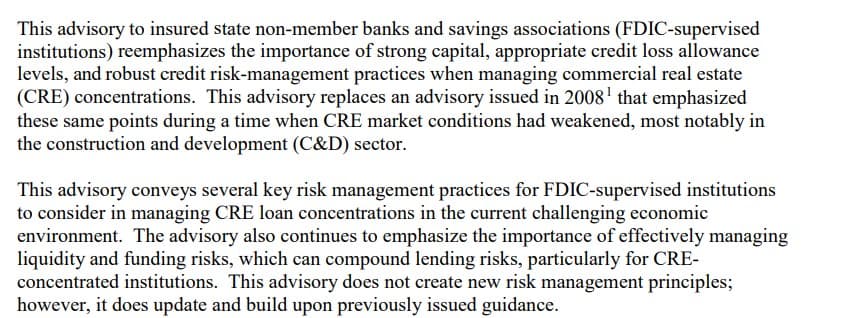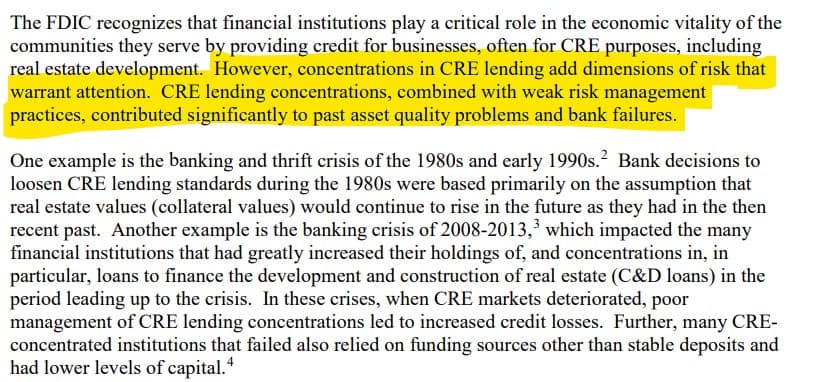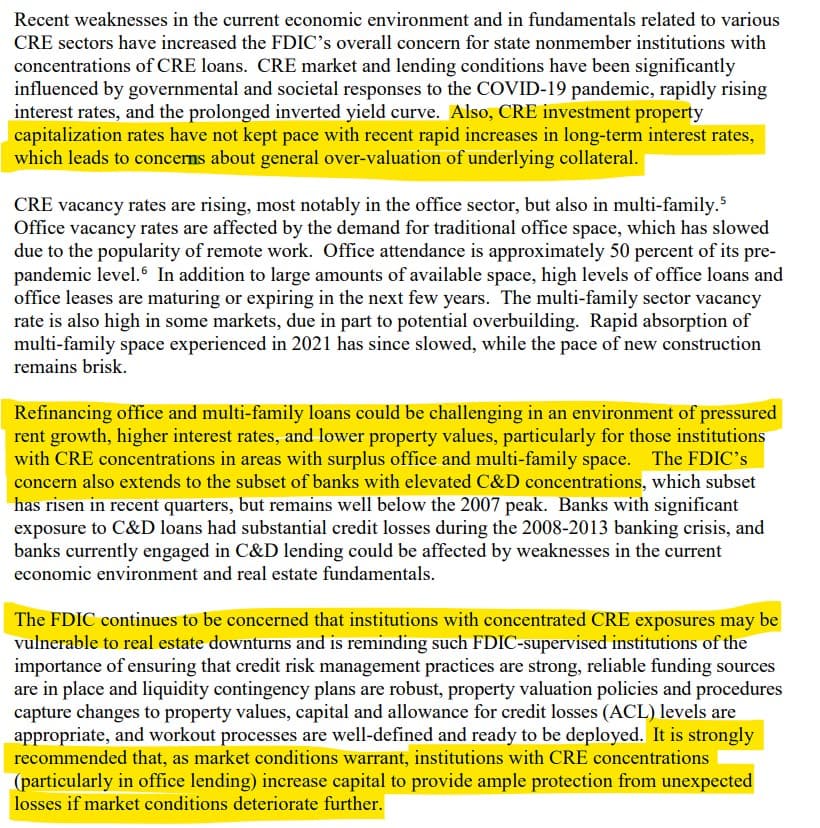The FDIC issues advisory to reemphasize the importance of strong capital, appropriate credit loss allowance levels, and robust credit risk-management practices for institutions with commercial real estate (CRE) concentrations.


Previous Challenging Economic Environments:

"CRE lending concentrations, combined with weak risk management practices, contributed significantly to past asset quality problems and bank failures."
Current Challenging Economic Environment and Real Estate Conditions:

"CRE investment property capitalization rates have not kept pace with recent rapid increases in long-term interest rates, which leads to concerns about general over-valuation of underlying collateral."
The FDIC has identified six key risk-management actions to help institutions with significant C&D and CRE concentrations manage through changes in market conditions:
- Maintain Strong Capital Levels:
Capital provides institutions with protection against unexpected losses, particularly in stressed markets. Institutions with significant C&D and CRE exposures may require more capital because of uncertainty about market conditions causing an elevated risk of unexpected losses. As market conditions warrant, proactive directorates and management take steps to increase capital levels to support significant CRE concentrations and mitigate the impact of potential loss. Maintenance of an appropriate level of capital to protect an institution from unexpected losses related to C&D and CRE concentrations is an important consideration when contemplating cash dividends.
- Ensure that Credit Loss Allowances are Appropriate:
Institutions are expected to determine their ACLs in accordance with U.S. generally accepted accounting principles (GAAP) and regulatory reporting instructions, relevant supervisory guidance, their stated policies and procedures, and management’s best judgment. Prudent credit management includes periodic, at least quarterly, analysis of the collectability of CRE and all other exposures and maintenance of ACLs at a level that is appropriate to cover expected credit losses on individually evaluated loans, as well as expected credit losses in the remainder of the loan portfolio. In reviewing their ACL methodology, institutions with significant C&D and CRE concentrations are advised to consult recent supervisory guidance. In accordance with GAAP, management should consider the effects of past events, current conditions, and reasonable and supportable forecasts on the collectability of the institution’s loans. Specifically, GAAP requires management to use relevant forward-looking information and expectations drawn from reasonable and supportable forecasts when estimating expected credit losses. While historical loss information generally provides a basis for an institution’s assessment of expected credit losses, management should consider whether further adjustments to historical loss information are needed to reflect the extent to which current conditions and reasonable and supportable forecasts differ from the conditions that existed during the historical loss period.
- Manage C&D and CRE Loan Portfolios Closely:
Consistent with Parts 364 and 365 of the FDIC Rules and Regulations and their appendices, institutions should maintain prudent lending standards and credit administration practices that consider the risks of material C&D and CRE concentrations. This includes management information systems that provide the board and management with relevant data on concentrations levels and related market conditions, including for concentration or market segments, as appropriate.
Portfolio and loan level stress tests or sensitivity analysis can be an invaluable tool in identifying and quantifying the impact of changing economic conditions and changing loan level fundamentals on asset quality, earnings, and capital. Applying adverse scenarios while conducting stress tests or sensitivity analysis helps banks adjust risk management processes, capital planning, liquidity management, collateral valuation processes, and workout procedures to prepare for credit risk problems before they impact earnings and capital. Additionally, appropriate risk management practices include maintaining a strong credit review and risk rating system that identifies deteriorating credit trends early. It is important for institutions to effectively manage interest reserves and loan accommodations, reflecting the borrower’s condition accurately in loan ratings and documented reviews.
- Maintain Updated Financial and Analytical Information:
Prudent institutions with CRE and/or C&D concentrations maintain recent borrower financial statements, including property cash flow statements, rent rolls, guarantor personal statements, tax return data, and other income property performance information to better understand their borrowers’ ability to repay and overall financial condition and enable timely identification of adverse trends. Such institutions emphasize global financial analysis of obligors, including in relation to pending loan maturities and lease expirations, as well as the concentration of individual property owners, builders, or developers in a loan portfolio. As real estate market and individual property conditions change, it is important for management to consider the continued relevance of appraisals and evaluations performed during prior economic or market and interest rate conditions, and update collateral valuation information as necessary. Maintaining updated financial and analytical information provides key inputs to foster meaningful stress testing or scenario analysis described above.
- Bolster the Loan Workout Infrastructure:
Well prepared institutions ensure they have sufficient staff and appropriate skill sets to properly manage an increase in problem loans and workouts. Likewise, institutions that have a ready network of legal, appraisal, real estate brokerage, and property management professionals to handle additional prospective workouts are better situated for more positive outcomes.
- Maintain Adequate Liquidity and Diverse Funding Sources:
Since liquidity and funding risks may be compounded in challenging interest rate and economic environments, it is important for institutions to have a comprehensive management process for identifying, measuring, monitoring, and controlling liquidity and funding risks. Recent industry events have underscored risks related to relying on funding concentrations, such as high levels of uninsured deposits, and the importance of robust liquidity risk management and contingency funding planning. Institutions that have identified appropriate levels of cash and cash equivalents, that have identified and are able to use a stable and diverse range of funding mechanisms, and that have identified and tested sources of contingent liquidity, including establishing and testing access to the Federal Reserve Discount Window, are better positioned to profitably support CRE concentrations.
"identified and tested sources of contingent liquidity, including establishing and testing access to the Federal Reserve Discount Window, are better positioned to profitably support CRE concentrations."
Wut Mean?:
- The FDIC is issuing this advisory to reemphasize the importance of strong capital, appropriate credit loss allowance levels, and robust credit risk-management practices for institutions with commercial real estate (CRE) concentrations.
- It also conveys several key risk management practices for institutions to consider in managing CRE loan concentrations in the current challenging economic environment.
- Additionally, the advisory reemphasizes the importance of effectively managing liquidity and funding risks, which can compound lending risks, particularly for CRE-concentrated institutions--the Discount Window/BTFP aka the Liquidity Fairy.
- This advisory replaces the 2008 advisory.

TLDRS:
- The FDIC issues FIL to reemphasize the importance of strong capital and credit loss allowance levels, as well as robust credit risk management practices, for institutions with concentrated CRE exposures--replacing the FIL from 2008.
- The advisory also identifies key risk-management actions for financial institutions with significant CRE concentrations to manage through changes in market conditions:
- Maintain strong capital levels
- Ensure that credit loss allowances are appropriate
- Manage construction and development (C&D) and CRE loan portfolios closely
- Maintain updated financial and analytical information
- Bolster the loan workout infrastructure
- Maintain adequate liquidity and diverse funding sources--the Discount Window/BTFP aka the Liquidity Fairy



